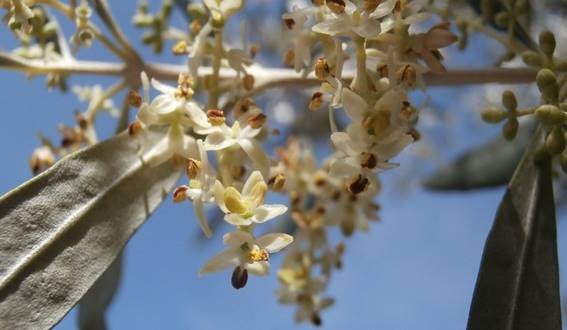“The olive tree cycle’s annual repetition is an endless-time procedure. In olive oil producing countries such as Greece, tourists can wander through olive groves all year, and observe the stages that the olive tree passes through. The olive tree development cycle is bounded to the seasons of the year, with the summer growth of olives, their autumn harvest, the winter landscapes, and the spring new branches, leaves, and blossoms. At every stage of the tree’s development cycle, people and nature work together to make the “Greek Golden Liquid”, being the ultimate living symbol of Greece, a symbol of peace, prosperity, health, and pride.”
The seasons of flowering and blossoming are the most attractive ones.
The beginning of the budding process in the tree starts with the arrival of the spring that brings a gradual increase in the temperatures, as well as more daylight hours. When this process begins, the buds open the new leaves as these stretch over the outer edge, thus giving rise to the growth of a new branch. This is why it is vitally important for the growth to be sufficient, as on these new branches other leaves will develop and other new buds, which will allow the olive tree to blossom the following year and which will, therefore, provide a fruitful future harvest. Budding changes the appearance of these trees due to the sap that is pushed onto their leaves by the roots. This is a clear sign of life that darkens or lightens the leaves as a prelude to its next stage: blossoming.
This process evolves as temperatures are rising during the summer period, with the olives growing under the hot sun, and then gazing at their silhouettes against the sunset. Small, whitish flowers are borne in loose clusters in the axils of the leaves, offering a spectacular view of the blooming olive trees.
FLOWERING
Olive trees produce fruiting shoots called inflorescences, which originate at the axil of a leaf. Each inflorescence will typically contain 10 to 30 flowers depending on the cultivar. The number of flowers that then mature into olives is dependent on a number of factors (abundance or lack of water, level of pruning, pest infestations, etc).
BLOOMING
Before flowers bloom, they go through a differentiation period that has to do with the sexuality of the blooms. This generally takes place March through May and results in one of two results (although there is some new research indicating that there may be a third possible result).
• PERFECT FLOWERS: Flowers which have both stamen (the male part) and pistil (the female part)
• STAMINATE FLOWERS: Flowers which have only stamens and lack a pistil (which apparently has been aborted)
POLLINATION
According to the Olive Production Manual (University of California, Agriculture and Natural Resources), “…some 500,000 flowers are present in a mature tree…” at time of full bloom. Within two weeks of full bloom, most of the flowers will have failed, with only 1 – 2% then maturing into full-grown fruit.
SELF-POLLINATION
Because of their geometry, olive flowers self-pollinate. The anthers (located at the top of the filaments attached to the stamen) drop pollen on the stigma of the pistil. The pollen grains germinate and olive growth is underway. Though not necessary for pollination, wind and bees may aid in pollination by disturbing the flower causing pollen to fall from the anther to the stigma.
CROSS-POLLINATION
Cross-pollination occurs when wind or a bee transfers pollen from one flower to the stigma of another flower. As bees are not particularly fond of olive flowers, they do not typically play a large role in the olive orchard. For a number of commercial California cultivars, cross-pollination is necessary to produce viable annual commercial crops. Care must be taken in determining which pollenating cultivars to mix with others in the orchard.
“Summer is a period when the olive tree undergoes its most beautiful phase of the year, the phase of flowering and blooming. However, each season offers its own beauty and uniqueness to the olive tree life cycle, making it always time to visit the olive groves of Greece”.



